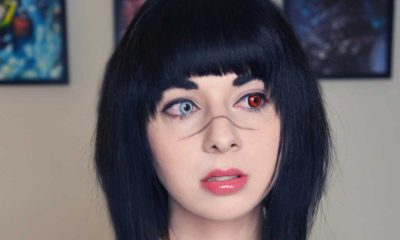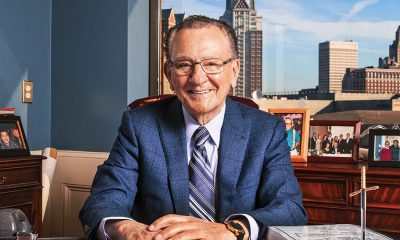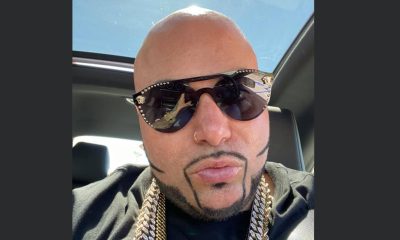Actors
The Untold Truth About Vivian Vance: Death Cause, Net Worth

Contents
Who Was Vivian Vance?
Vivian was an American actress best known for her role as Ethel Mertz in the TV series “I Love Lucy” (1951-1957), in addition to numerous other portrayals in film, TV, and theater.
Vivian Vance Wiki: Age, Childhood, and Education
Vivian Roberta Jones was born on 26 July 1909, in Cherryvale, Kansas, USA, the second of six children born to Euphemia Mae Jones and her husband Robert Andrew, Sr.
Vivian’s passion for acting was evident from a young age, but her mother’s conservative religious beliefs prohibited her from pursuing her dream. Despite her mother’s disapproval, Vivian was determined to follow her passion. After changing her last name to Vance, she left home and headed to Albuquerque, New Mexico, where she landed her first acting job at the Albuquerque Little Theatre. Her talent shone through, and she soon became a sought-after performer, appearing in several plays including “The Cradle Song” and “This Thing Called Love”. The support of the local theatre community enabled her to move to New York City, where she studied under the tutelage of Eva Le Gallienne, setting her on a path toward an illustrious career in entertainment.
Career Beginnings and Theater Success
After studying under Eva Le Gallienne in New York City, Vivian Vance began making a name for herself in the theatre scene, starting with her role in the Broadway production of “Music in the Air” in 1932. This was followed by appearances in several other Broadway shows, including “Anything Goes”, “Red, Hot and Blue”, and “Skylark” among others, all of which cemented her reputation as a versatile performer with a talent for comedy. Vivian soon became an audience favorite, and was often cast in roles that showcased her talent for making people laugh.
In 1940, Vivian appeared in “Out From Under”, a hit musical that ran for 337 performances on Broadway. She also appeared in “Let’s Face It!” in 1941, which ran for 500 performances, and “The Voice of the Turtle” in 1945, which was one of her most acclaimed performances on Broadway. Her role in this play earned her critical acclaim and a Theatre World Award for outstanding performance. She then appeared in “It Takes Two” (1947), a romantic comedy that also starred Bert Lahr.
The same year, she was part of the original cast of the Marc Blitzstein musical “The Cradle Will Rock”, which was controversial for its political themes and anti-establishment message. Vance received positive reviews for her performance as Moll, a character that reflects the desperation and struggle of the Depression era.
Transfer to Television and International Success
With her appearances in two films, Vance began to expand her career beyond theater. However, it was her role as Ethel Mertz on the television show “I Love Lucy” that would make her a household name. Despite initial resistance from Lucille Ball, Vance won the role of Ethel Mertz due to her exceptional performing skills and the recommendation of director Marc Daniels. Her on-screen chemistry with William Frawley, who played her character’s husband, Fred Mertz, was undeniable, but their offscreen relationship was strained.
She became the first actress to win an Emmy Award for Outstanding Supporting Actress in 1953, and she was nominated three more times before the series ended in 1957.
From 1962 to 1965, she rejoined Lucille Ball in the new sitcom “The Lucy Show”, portraying Vivian Bagley, a divorced mother with a child, who shares a house with Lucille.
In the third season, Vance was absent from seven of the twenty-six episodes due to her growing dissatisfaction with the weekly commute from her home on the East Coast to Los Angeles. Furthermore, Vance’s working relationship with Ball had become strained. Consequently, Vance requested a new contract that offered more creative control and better pay, but producers didn’t comply, mistakenly believing that she wanted to be Ball’s equal. Both Ball and Vance felt betrayed, leading Vance to leave the series. Ball considered ending the show without Vance, but later regretted not fulfilling Vance’s requests. After they reconciled, Vance made three guest appearances in the remaining seasons of the show.
📺DEBUT: ‘The Lucy Show’ starring Lucille Ball and Vivian Vance premiered 59 years ago, October 1, 1962, on CBS pic.twitter.com/JpJvNdBWzb
— RetroNewsNow (@RetroNewsNow) October 2, 2021
Later Career
After leaving “The Lucy Show”, Vance continued to work on various television shows, including “The Red Skelton Hour” and “The Great Adventure”. In 1967, Vance starred in her own sitcom, “The Vivian Vance Show”, but which was canceled after just one season and six episodes due to low ratings. She also appeared in several stage productions, including “The Time of the Cuckoo” and others.
In 1970, Vance reunited with Ball for a new television series, “Here’s Lucy”, in which she made several guest appearances as various characters. Vivian worked on a few theater credits late in her career, including “Harvey” on Broadway, in which she featured with James Stewart.
Vivian’s last on-screen role was in the TV series “Sam” (1978).
She was awarded a star on the Hollywood Walk of Fame posthumously in 1991.
Net Worth
According to authoritative sources, Vivian Vance’s net worth was estimated at $10 million at the time of her death.
Personal Life, Marriage, Husband, Children
Vivian was married four times. Her first three marriages ended in divorce, and she didn’t have children. Her first husband was Joseph Shearer Danneck, Jr., from 1928 until 1931. From 1933 to 1940, she was married to George Nathan Koch.
In 1941 she married actor Philip Ober, who reportedly was abusive towards her due to being envious of her illustrious career; they divorced in 1959.
From 1961 until her death in 1979, she was married to John Richard Dodds, with whom she lived in Stamford, Connecticut, until 1974, when they moved to California and lived there until Vivian died.
Declining Health and Death
Vivian had a nervous breakdown in 1945, and until her death, spoke of the importance of mental health. For this, she was honored by the State of Connecticut Department of Mental Health for her contributions on behalf of the mentally ill.
Vivian had problems with health throughout the ’70s. In 1973 she was diagnosed with breast cancer, and four years later, she suffered a stroke that left her partially paralyzed. She died on 17 August 1979 of metastatic breast and bone cancer at 70 years of age.
Actors
The Untold Truth Of Steve Buscemi’s Son – Lucian Buscemi

Lucian Buscemi is an American musician and actor, born on 30 June 1990 in New York City, USA. He’s known for being the son of actor, producer and director Steve Buscemi.
Contents
Early Life
Lucian is the only child resulting from the marriage between Steve Buscemi and Jo Andres.
Details about Lucian’s educational background are unknown. However, it has been disclosed he spent his childhood in Park Slope, Brooklyn.
Despite his parents’ movie-oriented professions, Lucian developed a deep interest in rock and alternative music instead. Influenced by his father, Lucian came to love and grew up listening to the ‘70s legendary punk bands The Ramones and The Clash. He also counts Korn, Blink-182 and Green Day as his influences.
https://www.instagram.com/p/BxhpTZAlben/
Inspired by various music genres, Lucian Buscemi started learning to play various instruments at an early age. Nowadays he’s considered a multi-instrumentalist, as he plays the piano, guitar and bass.
Career
Hollywood – Actor & Musician
Lucian Buscemi’s career as an actor started very early in life, when he was only six years old, as he was cast in a minor role in the movie “Trees Lounge”. Premiered in 1996 and written and directed by Lucian’s father Steve Buscemi, this film centers around a mechanic named Tommy, who lets life pass by while he makes excuses not to leave his alcoholic ways.
In 2007 Lucian was involved i the soundtrack of “Interview”, with his band Fiasco’s song “0157: H7 (Spy Song)”.
The movie starring and directed by his father Steve, is a remake of “The Departed” and although its script received mixed critiques, it was also well reviewed by experts due to its execution.
In 2011 Lucian collaborated in the original soundtrack (OST) of the movie “4:44 Last Day on Earth”. The film – which received mixed reviews – is a SCI-FI drama directed by Abel Ferreira, and is centered in the story of two lovers spending the end of the world together in New York.
Also in 2011, Lucian worked in the sound department of the movie “Sal”, which is based on the real story of the actor/musician Sal Mineo.
Music Career – Fiasco
Along with Jonathan Edelstein and Julian Bennett Holmes, Lucian Buscemi – who was 16 years old at the time – formed the band Fiasco. Fiasco’s sound didn’t fit in only one genre, as the members of the band were inspired by many bands such as Bad Brains, Don Caballero and Lightning Bolt.
Often defined as a mix of math rock and hardcore punk, Lucian told Gothamist that the band members were musically inspired by their personal experiences and preferences: ‘We basically all got into hardcore punk via word of mouth and the internet, and then we wanted to play that style of music.’ As such, he considers the creation of Fiasco wasn’t determined by their environment or social background: ‘Kids getting into that style of music could happen anywhere.’
Despite starting as a cover band, this didn’t deter the members from experimenting with their sound, slowly improving and developing a more unique style: ‘It got noisier and more complex I guess. We started to play in odd time signatures, and the riffs we started writing became harder to play.’ Regardless of the changes the band went through, Fiasco still preserved their punk influences throughout its career.
After signing with the independent company Impose Records, in 2007 Fiasco released their first album – “God Loves Fiasco” – which contained 23 tracks and gained the band recognition in the local music scene of Brooklyn. After that they released various albums such as “Native Canadians” in 2008, “Fabolous Bozo FP” in 2009, and the single “Sinus Rhythm Breakdown” in 2012. These works were highly acclaimed by the public, leading the band to be showcased by not only rock music-especialized magazines, but by several mainstream media platforms.
Fiasco also toured the US several times but entered an indefinite hiatus in 2012, although apparently while in production of the single “Sinus Rhythm Breakdown”.
Its members concentrated on their personal projects – Buscemi has done more acting, in movies such as in “Interview”, “Tree Lounges” and “The Sopranos”, and has also been involved in the soundtracks of several Hollywood productions.
It’s unknown exactly what Lucian Buscemi is doing nowadays.
Personal Life
Romantic Relationships
Lucian Buscemi maintains his romantic life in private. Due to this there’s no information about his partners or marital status, but he’s presumed to be single, and doesn’t have children.
Famous Parents
Father – Steve Buscemi
Lucian’s father is Steve Buscemi, the highly acclaimed American actor, writer and director who has appeared in movies such as “Reservoir Dogs” and “Desperado”.
Steven Vicent Buscemi was born in New York, the son of John and Dorothy Buscemi of Italian and Irish descent. Along with his parents and three brothers, Steve moved from Brooklyn to Nassau County. Steve matriculated from Valley Stream Central High School in 1975, then enrolled into Nassau Community College, though he later transferred to the Manhattan-based Lee Strasberg Institute.
Although Steve was always interested in acting, his first job was as a firefighter. He worked in New York from 1980 to 1984, when he moved to Los Angeles and made his Hollywood debut in the No Wave Cinema’s movie “The Way It Is”. After that he was cast in various minor roles in productions such as “Parting Glances” and “Miami Vice”.
In 1989 he appeared in the movie “Mystery Train”, for which he was nominated as the Best Supporting Male at the Spirit Awards of that year.
His outstanding performance in said movie helped him to gain a spot in the cast of the movie “Millers Crossing” in 1990.
In 1992 Steve Buscemi finally obtained his first starring role, as Adolpho Rollo in the movie “In The Soup”. The same year he would be cast as Mr. Pink in “Reservoir Dogs”, one of his most memorable roles to date, and for which Buscemi won the category of Best Supporting Male at the Spirit Awards.
In 1996 Buscemi acted in the movie “Fargo” as the protagonist Carl Showalter. This role was positively received by experts, and was followed by other character roles in productions such as “Con Air” in 1997, the 1998 film “The Big Lebowski”, and “Ghost World” of 2001. For the latter he won the Chicago Film Critics Association Awards category for Best Supporting Actor.
During these years, Buscemi also debuted as a voice actor, giving his voice to various memorable characters of animated movies “Monsters, Inc.” and its prequel, “Home On The Range” of 2004, and the 2006’s “Monster House”.
Other important roles of Buscemi’s career have been as Tony Blundetto in the classic “The Sopranos” of 2004, and as Enoch Thompson in the series “Boardwalk Empire”, a role for which he won the Best Actor category at the Golden Globe Awards in 2010.
In 1992 Steve Buscemi made his debut as a director, with the short film “What Happened to Pete”, which was followed by “Trees Lounge” in 1996. In the 2000s he also directed “Animal Factory”, “Lonesome Jim” and “Interview”.
Buscemi’s career as a series director has also been successful, having worked on the web show “Love”, and TV series “The Sopranos” and “30 Rock”.
Mother – Jo Andres
Although less prominent than her husband, Lucian’s mother Jo Andres was a talented film-maker, dancer and artist. Her artistic works were featured in several galleries in New York, while she also worked and collaborated with Wooster Group, Rockefeller Study Center and Yaddo. Her most acclaimed work was the movie “Black Kites” of 1996, which was screened in several renowned international film festivals.
https://www.instagram.com/p/BshcDRdAIJK/
Andres also directed the short film “Liquid Tara” in 2012, and Diana Krall’s music video for the song “When The Curtain Comes Down”.
Buscemi & Andres’ Story
Steve Buscemi and Jo Andres met in 1983, and started dating immediately. In 1987 they married, and managed to maintain a happy family life for decades, despite their busy careers.
Unfortunately, Jo Andres died in January 2019 after battling ovarian cancer for several years. Regarding his loss, in 2020 Buscemi told GQ Magazine: ‘If I should happen to go not suddenly, I hope I could be as present as Jo was. She led the way. She was surrounded by friends and family.’
Net Worth
Lucian Buscemi has an estimated net worth of over $5 million, which is largely the result of his career as a musician.
Physical Appearance
Lucian Buscemi is a man of white ethnicity. He has brownish-blonde hair and green eyes. He’s 5feet 8ins (1.72m) tall, but his weight is unknown.
Other Interesting Facts
All of Fiasco’s band members were multi-instrumentalists.
Lucian doesn’t have any public social media accounts.
One of Buscemi’s favorite concert venues in New York was Silent Barn.
Although his band Fiasco often cited big name musicians as their influences, Lucian told Impose Magazine otherwise: ‘We also have influences that suck but you just don’t hear them’.
Actors
The Untold Truth Of Ricky Schroder’s Daughter – Faith Schroder

Contents
Early life, family, educational background
Faith Violet Schroder is an American model, actress and the daughter of “NYPD Blue” and “Silver Spoons” actor, Ricky Schroder. Faith was born on 8 August 2001 in Los Angeles, California USA, and grew up in Topanga Canyon. Her mother, Andrea Bernard is an actress and entrepreneur,. She has a sister, Cambrie Schroder, and two brothers, Holden Richard Schroder and Luke William Schroder. She attended Oaks Christian School.
Family’s personal life
Her grandparents are Diana Schroder and Richard Bartlett Schroder Sr. She is also related to actress Dawn Schroder, who is her aunt. Her sister Cambrie is an actress in “Our Wild Hearts”, which was produced and directed by her parents – she also got to co-star alongside her brothers and father.
https://www.instagram.com/p/B8w26WQnm7f/
Although her parents directed and produced the movie, its concept was originally Cambrie’s idea. She is also a social media influencer and model, and created the “Fit with Cambrie” dance team.
Career
Faith began dancing when she was four-years-old. At nine-years-old, she did her first commercial modeling shoot, for “Elle Italy.” She later shared in an interview, ‘Elle Italy was doing a kids photoshoot at my house, I walked by, and 5 minutes later I was in a barn with the horse getting my photograph taken. That’s where it all started.’
In 2013 she met Disney producers at Bella Thorne’s 16th birthday party. She was invited to appear in “Shake It Up” after she told them that she wanted to become an actress.
She auditioned for the show, received a callback and was cast as Jordan. In 2013 she also appeared in “Good Day LA” and “Home & Family.” In 2014, she won the Debby Allen Annual dance battle competition.
Elle Modeling Management signed her in 2017. She consistently walks for Frankie Bikinis, and in 2017 was featured as ‘Frankies Girl of the Month.’ She became a cast member in Lifetime’s popular reality television show, “Growing Up Supermodel,” and garnered support after appearing alongside her mother and Krista Allen, Kelly Le Brock, Shanna Moakler and others. The first season premiered on 16 August 2017 and ended on 20 September 2017, and was successful, and renewed for a second season.
The show follows the children of celebrities, and was born from the vast majority of celebrities’ children becoming famous themselves, primarily online; many people feel that it is unfair that they become famous so quickly and easily without much effort. The show also shows personal issues, such as Faith’s parents’ divorce and how hard she found that to be. In 2017 she was interviewed on Entertainment Tonight, where she said that having personal moments and every second filmed was very challenging for her. In 2018, she grew her Instagram account and walked in Frankies Bikinis shows. In 2019, she appeared as herself in his short video, “Luli Fama Take Over in the British Virgin Islands.”
Personal life
She is a very secretive person. She enjoys spending time with her sister; otherwise she stays tight-lipped about her own life.
Hobbies, favorite things and interesting facts
Justin Bieber is her favorite artist.
Her favorite songs are ‘Humble and Kind’ by Tim McGraw, “Angel” by The Weekend, ‘The Man’ by Nav. She drives a pink Chevrolet.
Appearance
She stands at 5ft 7ins (1.7m) tall, and weighs around 120lbs (55kg). She has hazel eyes and blonde hair.
Net worth and salary
Her net worth is estimated at $550,000, as of early 2020.
Who is Ricky Schroder?
Richard Bartlett Schroder was born on 13 April 1970 in Brooklyn, New York City USA, and grew up in Staten Island, New York. He is the younger brother of Dawn Schroder. His parents worked at AT&T. From a young age, he had an extreme interest in acting, as even at three months old, his mother would take him to photoshoots. She later quit her job to take care of the children fulltime, and by the time Ricky was six years old, he had already appeared in around 60 catalogues and advertisements.
he made his acting debut in 1979 when just nine-years-old, in “The Champ” as Jon Voight’s son. In 1980, he won a Golden Globe for Best New Male Star of the Year, so in the third grade Ricky’s parents pulled him out of school so he could focus on his acting career.
He moved to Los Angeles with his mother, while his father stayed behind in New York so he could keep working at AT&T. Soon after the move, he landed a role in “The Silver Spoons,” a television series, and gained more fans while he in the show from 1982-1987. He went to Calabassas High School, and later attended Mesa State College in Grand Junction, Colorado.
As an adult, he starred as Newt in “Lonesome Dove” and “Return to Lonesome Dove”. He also appeared in three seasons of “NYPD Blue.” His directorial debut was the music video for “Whiskey Lullaby” and the film “Black Cloud.” He acted in a few series, including “Little Lord Fauntleroy,” “The Stranger Within” and “The Earthling.”
For “The Earthling” and “Silver Spoons,” he received Young Artist Award, and also won Director of the Year for “Whiskey Lullaby.”
He met Andrea in 1992, when filming “Blood River”; they dated for a few months and then married on 26 September that year, and went on to have four children together. After being married for 24 years, Andrea filed for divorce in June 2016, and it was finalized in 2017. Ricky has not been romantically linked with anyone since.
His net worth is estimated at $8 million, as of early 2020.
Actors
Who is Ziv Zaifman on ‘The Greatest Showman’? – Biography

Contents
Who is Ziv Zaifman?
Ziv Zaifman was born on 7 July 2004, in Clearwater, Florida, USA, and is an actor as well as a singer, best known for his work on the film “The Greatest Showman”. While he didn’t have a role in the film, he provided the singing voice for actor Ellis Rubin, who was portraying a young PT Barnum.
The Riches of Ziv Zaifman
As of early-2020, Ziv Zaifman has a net worth estimated to be over $200,000 earned through a bit of success in the entertainment industry. He’s been involved in a few acting projects, though “The Greatest Showman” remains as his biggest success commercially. As he is still young, time will tell if he will continues in the acting field or pursue another.
A Million Dreams @GreatestShowman 🎩 Full Video on: https://t.co/GMBTB2Kgy9 #AmillionDreams #GreatestShowman #butlins #skegness @RealHughJackman @RealMichelleW #zivzaifman #hughjackman #michellewilliams #rt pic.twitter.com/DsFCBfxyDq
— BOOMIN (@boominband) August 15, 2018
Early Life and Career Beginnings
Ziv grew up in Florida, and at a young age demonstrated talent in singing. He loved performing, and aspired to find a career as a film actor, using his talents in singing to help him land roles in musicals or the like.
One of his first acting roles was in an episode of the show “The Blacklist” in 2017; starring James Spader, it follows the story of a criminal who was formerly an officer in the US Navy, and after eluding the Federal Bureau of Investigation (FBI) for many years, he gives himself up to become an informant, convincing them that he’s compiled a blacklist of all the most dangerous criminals in the world, and is willing to give up the information in exchange for immunity.
The show has been acclaimed throughout its run, which made it a great first step for Zaifman, though he only had a small role in one episode.
PT Barnum – A History
Zaifman’s next project would be his most career-defining so far, as the singing voice of Ellis Rubin in “The Greatest Showman”. The show is a biographical film, depicting the life of showman Phineas Taylor Barnum or PT Barnum, who founded the Barnum and Bailey Circus, which for its entire run marketed itself as “The Greatest Show on Earth”, hence the name of the film.
Barnum was a small business owner who discovered a desire to pursue a career in entertainment. He first purchased Scudder’s American Museum which he used as a platform to market various hoaxes such as the Fiji Mermaid, actually a monkey sewn into a fish, making it look like the skeleton of a mermaid. These hoaxes were what he would become known for though – in 1850, he partnered with opera singer Jenny Lind for an American tour spanning 150 nights, for which he paid her an unprecedented $1000 a night for her work. While he suffered numerous setbacks during this period, his museum flourished, expanding and gaining the first aquarium in the US.
The Later Career of PT Barnum
While Barnum’s most enduring and celebrated achievement was his circus, his later career was marked with service in the government, as he became a member of the Connecticut Legislature. He was highly inclined to a change in the US Constitution, opposed to practices of slavery, expressing his Christian beliefs that a soul should not be subject to involuntary servitude. He also fought for causes such as street lighting, prostitution laws, liquor limitations, and better water supply to the state, plus establishing the Bridgeport Hospital in 1878. Most of these achievements were overshadowed by his traveling circus and museum filled with freaks, as the public would call it.
The Success of The Greatest Showman
The film gained a lot of traction since its announcement, gaining high profile acting talents such as Hugh Jackman, Zendaya, and Zac Efron. The film takes inspiration from Barnum’s museum and his career in entertainment, most notably his work with Lind as well as his circus. The film’s production took most of 2017, with its release scheduled for later in the year. The film had a mixed reception from critics, though it did not stop generally positive acclaim for its music, production, and acting performances. Hugh Jackman gained numerous nominations for his work, and the music of the film gained numerous nominations, with the song “This Is Me” winning a Golden Globe Award for Best Original Song.
While its soundtrack gained a lot of attention, it was also noted that several actors didn’t sing their respective songs. Zendaya, Hugh and Zac performed their songs, while Loren Allred provided the voice for actress Rebecca Ferguson, who portrayed the Swedish Nightingale Jenny Lind. Ziv also sang, and can be heard on the track “A Million Dreams”. The film was successful commercially, becoming the third highest-grossing musical in the US, earning a total of $435 million worldwide, as opposed to its $84 million budget.
Recent Work and Personal Life
Since the success of “The Greatest Showman”, Zaifman has had one other film project, a follow-up from his work in the previous film, cast in the 2018 independent film “To Dust”, which starred Matthew Broderick and Geza Rohrig.
https://www.instagram.com/p/Beygk-snIzU/
The film premiered at the Tribeca Film Festival, and tells the story of a Jewish man who tries to move forward after losing his wife to cancer. He then finds an unusual partnership with a rabbi and a biology professor.
Following his work there, things have been quiet for Ziv in the last few years. The speculation is that he is continuing his education, and may eventually take more acting opportunities as thery comes. However, there is also a possibility that he may not follow through with his initial acting work, as is the case for several child actors.
Ziv is young and single, not likely focused on finding any long term relationship as he is still focused on education. He’s also just begun in his career in the entertainment industry, which may leave him little in terms of time for a girlfriend. Not a lot of information has been revealed about him, apart from his love for singing and acting.
-

 Instagram Stars3 months ago
Instagram Stars3 months agoKatelyn Runck – Measurements, Height, Age. Plastic Surgery?
-

 Twitch Stars1 month ago
Twitch Stars1 month agoThe Sphere Hunter’s Biography: Trans? Age, Face, Real Name
-

 Actors6 months ago
Actors6 months agoWho is Dylan Llewellyn? Age, Height, Gay? – Biography
-

 Youtube Stars3 months ago
Youtube Stars3 months agoHow Rich is Judge Frank Caprio? Net Worth, Salary, Family, Bio
-

 Instagram Stars4 weeks ago
Instagram Stars4 weeks agoThe naked truth of Claire Abbott’s disappearance: Where is she now?
-

 Web Stars6 hours ago
Web Stars6 hours agoWho actually is Hard Rock Nick? Net Worth, Real Name – Wiki
-

 Businesspersons4 weeks ago
Businesspersons4 weeks agoThe Untold Truth Of Brandi Love’s Husband – Chris Potoski
-

 Celebrity Spouses2 months ago
Celebrity Spouses2 months agoThe Untold Truth Of Rashida Tlaib’s Husband – Fayez Tlaib














































